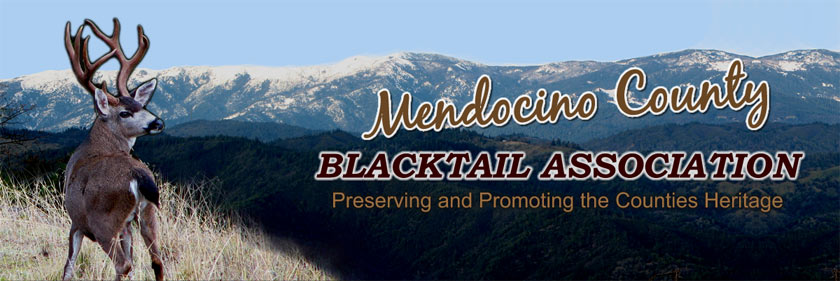The Mendocino National Forest Deer Restoration Plan
"Addressing the decline of the Columbian Blacktail Deer"
By Paul J. Trouette
From the information given to us from the Spanish adventurers
and settlers, to the trappers and explorers from the early settling
of the Americas; we know that deer were abundant throughout the coastal ranges,
and inland to the foothills of the Sierra Cascade mountains. Over
time -- particularly from the 1820's to the turn of the century --
deer were utilized for food and for clothing, and through severe
market hunting were almost entirely wiped out in northern California.
Thanks to proper management from the creation of the CA Dept of
Fish & Game in 1907; regulations were placed on deer hunting,
and the numbers of deer began to increase dramatically.
By 1922, deer were numerous in the Mendocino National Forest, and
a census of the feeding grounds revealed a population of nearly
40,000. (this number comes from a survey of California deer herds 1952) In 1954,
Mendocino County had a record harvest of bucks; which was an
astounding 5,232. Unfortunately, by the year 2000 the predictions
of our biologists and old timers were coming true. In 2000, the
harvest of bucks was 1,256. This represents a decline of 3,976
bucks per year.For over 100 years the County of Mendocino has
enjoyed it's tradition of deer hunting on both private and public
lands; such as the Mendocino National Forest and BLM properties.
We have also enjoyed the tremendous economic benefits to our
little towns from sportsman all over the state, not
to mention the notorious stigma from the trophy clubs who deem
Mendocino County as "The Big Buck Capital" of the USA. Mendocino
County is the number-one county for Boone & Crockett entries
into the record books for blacktail deer. This county has an
obligation to restore its tradition of deer hunting, and to
ensure its survival for future generations; as an economic
benefit as well as a time-honored tradition.
What is the value of a deer in 2007?
During the 2007 hunting season, hunters were asked to participate in an
economic survey regarding their expenses on hunting trips to
Mendocino County. Here are some of the results:
- An average weekend trip was between $150.00 to $300.00
- An average hunter spent approximately 2 to 4 trips per
season, or 4 to 8 days in the field
- Local hunters spent more than ten days in the field.
- Total average dollars spent to harvest a single deer ranged
from $600 to $1114 per season.
- Total expense on average per hunter to harvest one-to-two
deer was $857.00.
In 2006, Fish & Game sold 39,800 tags for the B-zones.
39,800 x an average cost of a B-zone season per hunter of $857
equals, $34,108,600 just in the B-Zones alone.
Private Land Management hunts or (PLM'S)
These Hunts cost an average of $3,500-$7,000 with
trophy fees, and with blacktail deer gaining recognition in the
Outdoor Channel television market, many of these dollars are spent
in Mendocino County in search of Boone & Crockett
trophies. Local guides spend numerous dollars in the county year
around searching for animals for their clients, as well as managing
their lands where all wildlife benefit through this program. PLMs
have much more deer on average than public lands because of this
excellent management.
Golden opportunity Tags/ Open zone tags
These tags, commonly known as "governor's tags",
generate over $185,000 from hunting blacktail deer every year; and guides
are paid in the $1,000's for their services helping hunters in search of a trophy
blacktail buck. All the tag costs go directly back into Fish &
Game for deer management. Guide fees are spent in local cities.
Our Plan
Our plan is to educate the sportsman (as well as the non-sportsman)
to the serious decline of our wonderful resource in our
world-renowned county. We work to increase the deer populations in
our national forest lands to a sustainable balance, utilizing
proper management for our personal and economic benefit. Through
habitat management, and consistant deer ecology, we can expect
significant results over a ten-year plan. Fire and mechanical
manipulation are the desired means to achieve our results.
Predation analysis, and management play a large role as well.
We will actively engage and work with the U.S.F.S., the agency responsible for
the management of the wildlife habitat in the National Forestlands.
Funding Plans or structure
We will be generating funds through a public donation program
of outdoor sports enthusiasts (and others) who frequent the
National Forestlands.

